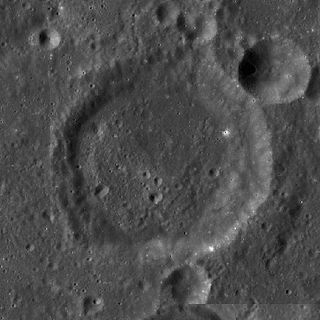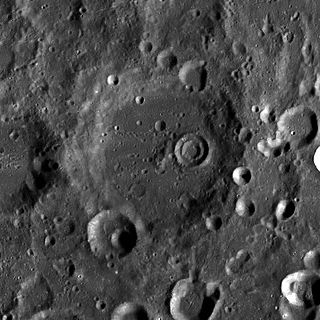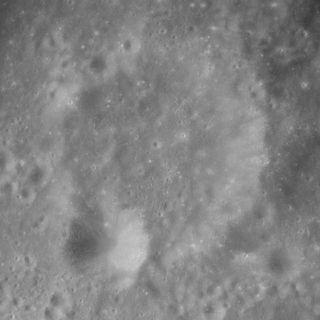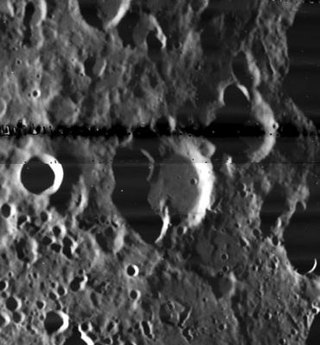
Cabannes is a lunar impact crater that lies in the southern hemisphere on the far side of the Moon. The rim has been worn by subsequent impacts, with a smaller crater overlying the southern rim. However the formation has not been significantly reshaped by nearby craters.

Abul Wafa is an impact crater located near the lunar equator on the far side of the Moon, named after the Persian mathematician and astronomer Abu al-Wafa' Buzjani. To the east are the crater pair Ctesibius and Heron. In the northeast lies the larger crater King, and to the southwest is Vesalius.

Cartan is a small lunar impact crater near the eastern edge of the Moon. It lies just to the west of the larger Apollonius. The rim is circular with a tiny crater along the eastern side. The interior floor is about half the diameter of the crater. A smaller crater attached to the southern rim is also attached to the north rim of Apollonius H, forming a short crater chain.

Chladni is a small lunar impact crater that lies near the northwest edge of Sinus Medii, in the central part of the Moon. The crater is named for German physicist and musician Ernst Chladni who, in 1794, wrote the first book on meteorites. The rim of the crater is roughly circular, and there is a small central floor at the midpoint of the sloping inner walls. This feature has a higher albedo than the surrounding terrain. It is connected by a low ridge to the rim of the crater Murchison, which lies to the northwest. Due east of Chladni is the larger Triesnecker.

Sacrobosco is an irregular lunar impact crater that is located in the rugged southern highlands to the west of the Rupes Altai escarpment. It is a readily identified feature due to the three circular craters that lie on its floor. The rim of Sacrobosco is heavily worn and eroded, especially in the northeast. The floor is relatively flat in the south, except where overlain by Sacrobosco A and B, but is somewhat irregular in the northeast.

Abenezra is a lunar impact crater located in the rugged highlands in the south-central section of the Moon. Abenezra is named after the Sephardic Jewish sage, poet, biblical commentator, and astrologer Abraham ibn Ezra. It is attached along the southeast rim to the crater Azophi. To the northeast lies the crater Geber, and further to the southeast is the larger Sacrobosco.

Cavendish is a lunar impact crater that is located in the southwest part of the Moon, to the southwest of the larger crater Mersenius. It lies between the smaller craters Henry to the west-northwest and de Gasparis to the east-southeast.

Al-Biruni is an impact crater that lies on the far side of the Moon, just beyond the eastern limb. This portion of the surface is sometimes brought into sight due to librations of the Moon, but due to its location the crater is viewed from the side. Al-Biruni lies to the south of the crater Joliot, and to the northeast of Goddard. It is named after the great Persian scientist Al-Biruni.

Almanon is a lunar impact crater that lies in the rugged highlands in the south-central region of the Moon. It was named after Abbasid Caliph and astronomer Al-Ma'mun. It is located to the south-southeast of Abulfeda, and to the north-northeast of the smaller crater Geber. The crater chain designated Catena Abulfeda forms a line between the south rim of Abulfeda and the north rim of Almanon, continuing for a length of about 210 kilometers to the Rupes Altai scarp.

Pons is a lunar impact crater that is located to the west of the prominent Rupes Altai scarp. It was named after French astronomer Jean-Louis Pons. It lies to the southeast of the crater Sacrobosco, and southwest of Polybius. To the northwest along the same flank of the formation is the crater Fermat.

Bohr is a lunar impact crater that is located near the western lunar limb, in the area that is affected by librations. It is attached to the southwestern rim of the larger, eroded Vasco da Gama formation, and to the southeast of the crater Einstein. The crater was observed for the first time in 1963, by Arthus and Ewen Whitaker in the book Rectified Lunar Atlas.

Büsching is a lunar impact crater that is located in the crater-covered southern highlands of the Moon. It was named after German geographer Anton F. Büsching. The similar-sized crater Buch is located adjacent to its southwestern rim, and further to the southwest lies Maurolycus.

Bell is a lunar impact crater that is located on the far side of the Moon, just past the western limb. It lies in an area of terrain that is marked by many small craters, a number of which are satellite craters of Bell listed in the table below. Bell lies within two crater diameters of Laue to the north, and to the west of the smaller Helberg.

Cyrano is a lunar impact crater that lies on the far side of the Moon. It lies due east of the huge walled plain Gagarin, and to the north of the somewhat smaller crater Barbier.

Cichus is a lunar impact crater that lies in the southwestern part of the Moon, at the eastern edge of Palus Epidemiarum. Just to the northeast and nearly contacting the rim is the lava-flooded crater remnant Weiss. The crater is named after Italian astronomer Cecco d'Ascoli.

Dale is a small lunar impact crater located in the far eastern part of the Moon's near side, to the south of the Mare Smythii. It lies to the southeast of the larger crater Kastner and northeast of Ansgarius. The crater is located in a part of the lunar surface that is subject to libration, which can hide it from view for periods of time.

Comstock is a lunar impact crater that is located on the far side of the Moon. It lies to the northeast of the walled plain Fersman, and north of the crater Weyl.

Cockcroft is a lunar impact crater that is situated on the far side of the Moon from the Earth, so that it has only been observed and photographed from orbit. It lies to the northeast of the larger crater Fitzgerald, and southeast of Evershed.

Douglass is a lunar impact crater on the far side of the Moon. It lies to the southwest of the crater Frost and south-southwest of the large walled plain Landau.

Fersman is a large lunar impact crater on the Moon's far side. It lies to the east of the crater Poynting, and west-northwest of Weyl. To the south is the huge walled plain Hertzsprung.
























